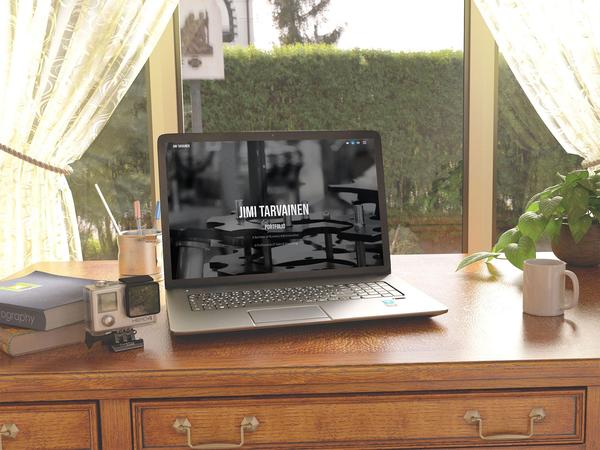
How to Build a Stunning Modeling Portfolio to Make Sure You Stand Out

Jessica Michael
Published onA professional modeling career can lead to great experiences like travel, meeting new people, and getting to work for some of your favorite brands. However, it's a highly competitive industry that often has many applicants for every gig. That's why it's incredibly important to make a great first impression with a spectacular model portfolio.
In this article, we'll teach you how to make a modeling portfolio that can get your foot in the door for those coveted jobs and agency representation and help you land the modeling gigs you want.
What is a modeling portfolio website?
A modeling portfolio website is an online, curated collection of photos and videos that highlight your unique look and your work experience. It includes professional photos, photos from campaigns you've been a part of, and any video work that you've done. It's also a place to link your resume, connect your social media, and tell potential clients a little bit about yourself.
A model portfolio website is the digital version of a printed lookbook. While you may still want or need a physical lookbook for modeling jobs, most of the time, a digital version is going to be more useful. That's because you can easily and instantly share it with just about anyone, which increases your chances of being hired. It's also much easier to update as you have new work that you can add, so you know you're always displaying the best of what you do.
The importance of a modeling portfolio website
Modeling portfolio websites are a great way to show off your range and professionalism. Like many jobs, the way you get hired is to show that you are the most qualified for the position. In the case of modeling jobs, a large part of this is being able to showcase photos that hit the mark for each client. A modeling portfolio allows you to display stunning photos across a wide range, from full body shots, to headshots, to lifestyle photos. With the help of professional photographers and some work experience, you can use your modeling portfolio to build your brand and easily convince clients that you are the best for the job.
In addition, with the right marketing skills, your modeling portfolio can become one of the ways you market yourself. By including your portfolio in your bio, you can make sure that anyone who follows you can easily find and view your portfolio.
Defining your brand and target audience
For many models, there's a delicate balance between showing enough range that a multitude of different clients will want to hire you and specializing your look so that you are unique and compelling. Defining your brand and target audience is a great way to figure out how to do that, and a modeling portfolio can help you appeal to your target audience without losing too much range. Here's a few questions to ask yourself before you begin building a model portfolio:
What kind of work do I tend to get hired for? Is it lifestyle work? Athletic/sports modeling? Is it high fashion? While it's great to always expand your range, it's also important to recognize what you are already excelling at. You can include previous work in your portfolio to showcase that you've already got the professional expertise for this kind of work.
What kind of work do I want to get hired for? Maybe you've been doing well with one type of modeling, but you'd like to take your career in another direction or add to your versatility. This is where working with a professional photographer can be really helpful. Hiring someone who knows how to photograph the kind of modeling work you aspire to do and including that in your portfolio can help you have the confidence to try for modeling gigs you really want to do.
Once you've defined your target audience and brand, make sure that your model portfolio website is designed with that in mind. Pick templates, color palettes, layouts, and fonts that accentuate your brand and add to the overall feel of your portfolio. And remember, the nice thing about a digital lookbook is that you can change it up easily as your brand or audience changes.
Why you should have a model portfolio as well as instagram
Instagram is a primary way that models get a chance to build an audience and create a distinct brand identity. It also shows agencies that you have an independent following, a must in today's modeling industry.
However, it has its limitations. Fortunately, a well-designed modeling portfolio works hand-in-hand with your Instagram account to increase your reach and land you modeling jobs.
Most brands and agencies want to know about your prior work experience and to easily view examples of different shots and styles. A modeling portfolio allows them to find what they're looking for quickly, as well as to view your work history.
An Instagram account can show your relevance and public appeal, and a modeling portfolio displays professionalism and range.
How to build a modeling portfolio
We've talked about why a modeling portfolio is important and a few things to consider as you're getting ready to build one. Let's dive into the nuts and bolts of how to create the modeling portfolio of your dreams.
What should a model portfolio look like?
Your modeling portfolio should be a reflection of your brand and look, which means it will be unique to you. That being said, there are some considerations that everyone should have when building a digital portfolio.
High-quality professional photos (and videos if you have them)
Wide range of photos: headshots, full body shots, varying angles and lighting,
Different types of modeling, ie lifestyle, fashion, commercial, etc.
An About Me section that explains who you are and what you do. Keep it professional, but don't be afraid to show your colors. Agencies want to see who you are.
A page for or a link to your professional modeling resume or tear sheet
Contact information
Social media buttons
The best portfolios are visually stunning, including only the best examples of what you do. They are also easy to navigate, with sections or pages that divide up shots or styles. Remember, this is the first step in getting a modeling job, so you want it to be clean, professional and impressive.
Selecting the right platform for your portfolio:
In general, there are two routes you can go for choosing a platform and developing a site.
The first is to hire a professional web designer. A web designer can create a very unique and custom site, one that perfectly expresses who you are. The downside is that it's often expensive, and you may have to continue to pay for updates and maintenance over time.
The second is to choose a website builder like Journo Portfolio with pre-existing templates and styles for you to choose from. You may not have endless options with a modeling portfolio website platform, but they are cost-efficient, can be built by you in a day, and are easy to maintain and update.
How to select photos that showcase your versatility
We've talked about the importance of professional photos, but how do you know which ones to include?
There are two main things to look for when deciding which photos you want in your portfolio: quality and versatility.
Quality: Curate your modeling photos to include only the best photos that show off your look and skills.
Versatility: Make sure you're not leaning too hard into one type of shot (headshots, etc). Instead, include a variety of shots and a range of the types of work you're interested in, whether it's lingerie, fitness or promotional.
What to include in your About section
An About section shows a modeling agency or client who you are, your work experience, and your personality. Feel free to include hobbies and life experience alongside your work philosophy and work history, but remember-- if you wouldn't say it in a job interview, you probably don't want to say it in your About section.
Importance of easy-to-find contact info
Once someone visits your model portfolio website, you want them to be able to contact you directly without having to search around on your site for your contact information.
It's great to have a contact form people can use, but it can seem a little impersonal. Many agencies and clients want to have your email address on hand, which they can't do through a contact form.
One option is to have your email listed at the bottom of each page, or to have a separate contact page that lists all of your contact info and is prominently displayed in your navigation menu. You can always have both a contact form and your contact info directly listed.
It's also a must to have your social media linked to buttons in your header or footer. That way they show up on every page. Social media is a huge part of modeling, so you want to make sure finding you on social media is as easy as finding your email.
The importance of keeping your portfolio up-to-date
Styles change, work history expands, and brand identities evolve. Having a modeling portfolio set up on a hosting platform that makes it easy for you to change and update it means you'll always have your freshest, most impressive looks on display.
Keeping your site updated also has the added benefit of helping your website be more attractive to Google, which increases your SEO and findability online.
Sample Modeling Portfolios
Kayla Arianne
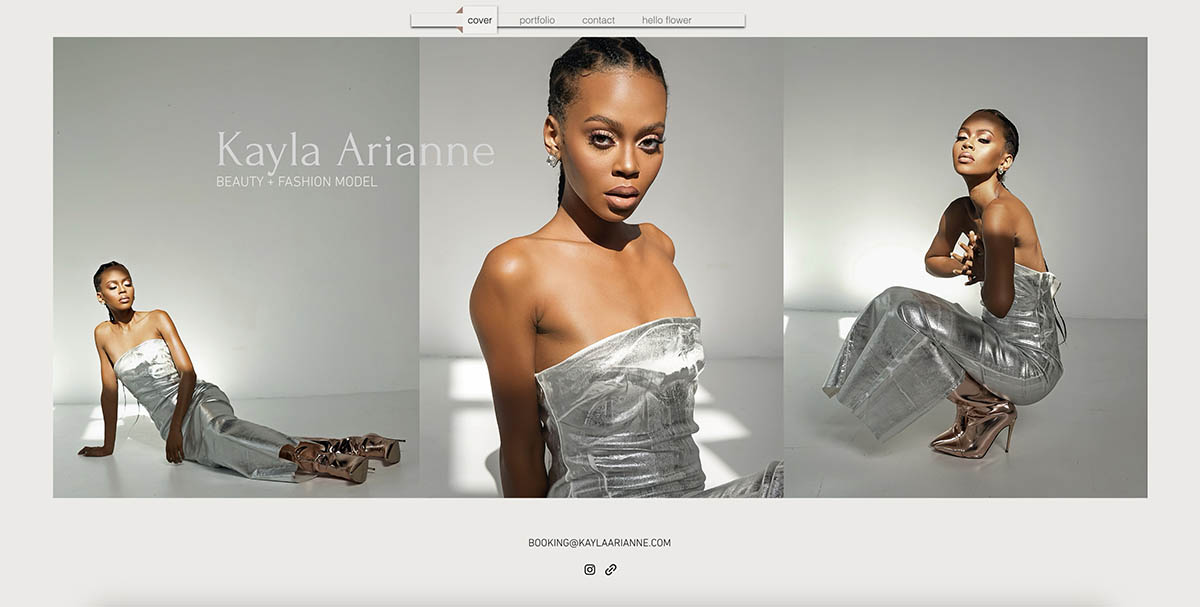
Kayla Arianne is a fashion and beauty model who lets her photos speak for themselves. Her portfolio is a great example of less is more, with very little included beyond her photos. Each photo is incredibly high-quality, and she includes a range of shots and looks. She also makes sure her email and social buttons are displayed at the bottom of every page.
Ciana Newman
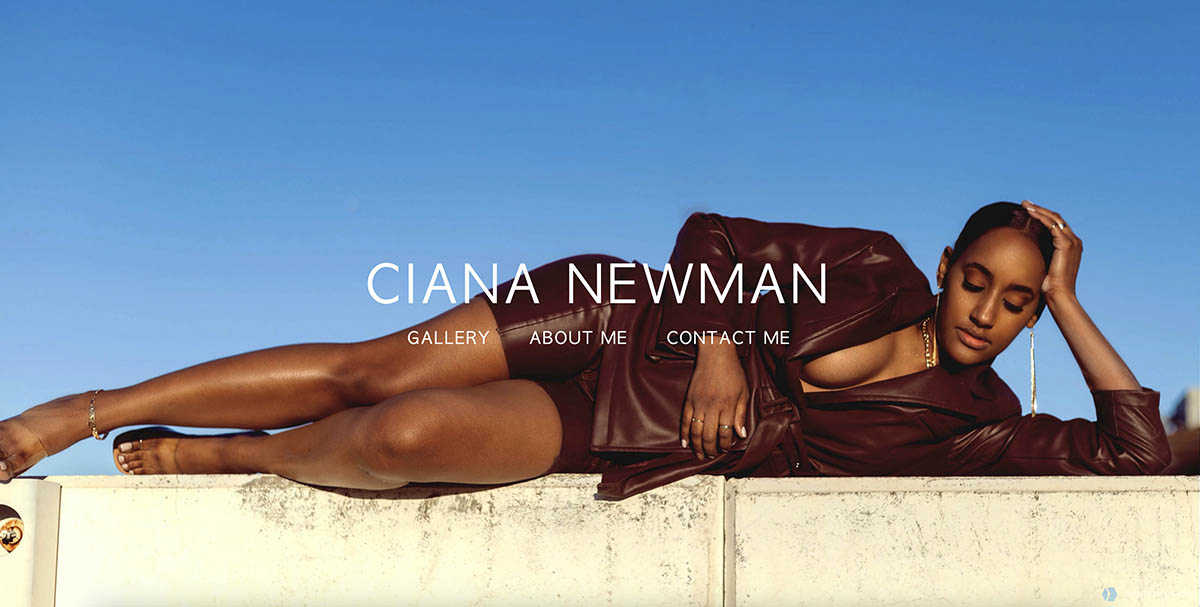
Ciana showcases her range with a collection of beautiful shots. Even though she is new to modeling, she's done a great job securing professional shots. Her About section is short but highlights her work experience and her unique personality.
Christen Dye
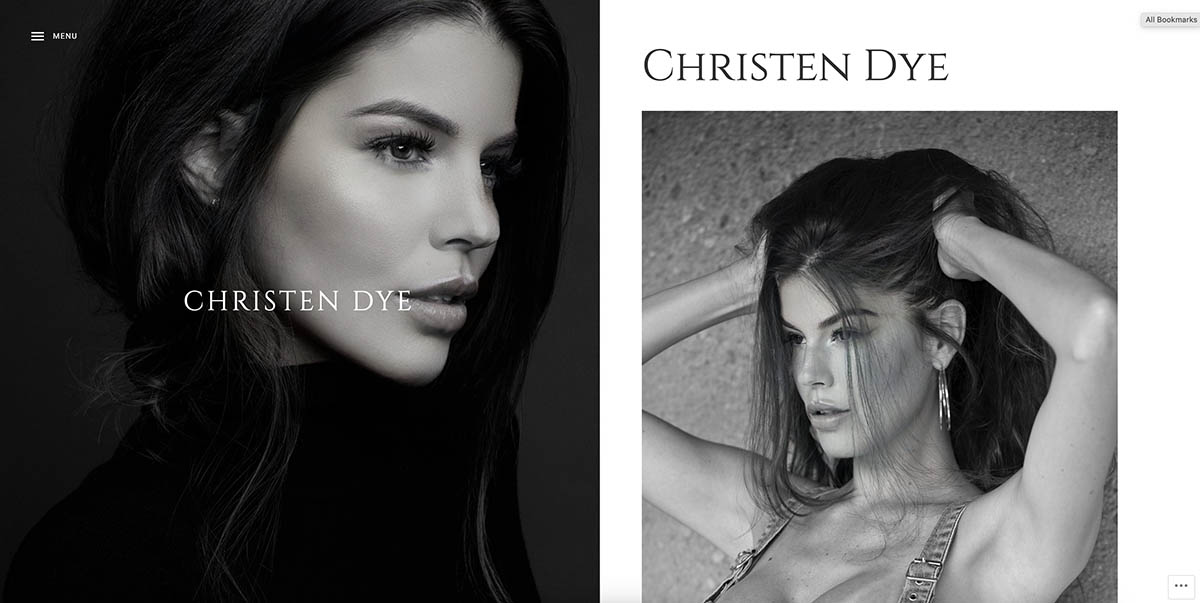
Christen Dye's portfolio makes use of her experience as a model and influencer, and includes her social media feeds on her site--a great option if you have a solid social following. Alongside a traditional portfolio section, she divides her work onto pages. This makes it easy for clients to view exactly what they're looking for and is a great option for anyone that has a full body of work.
Michelle Carney
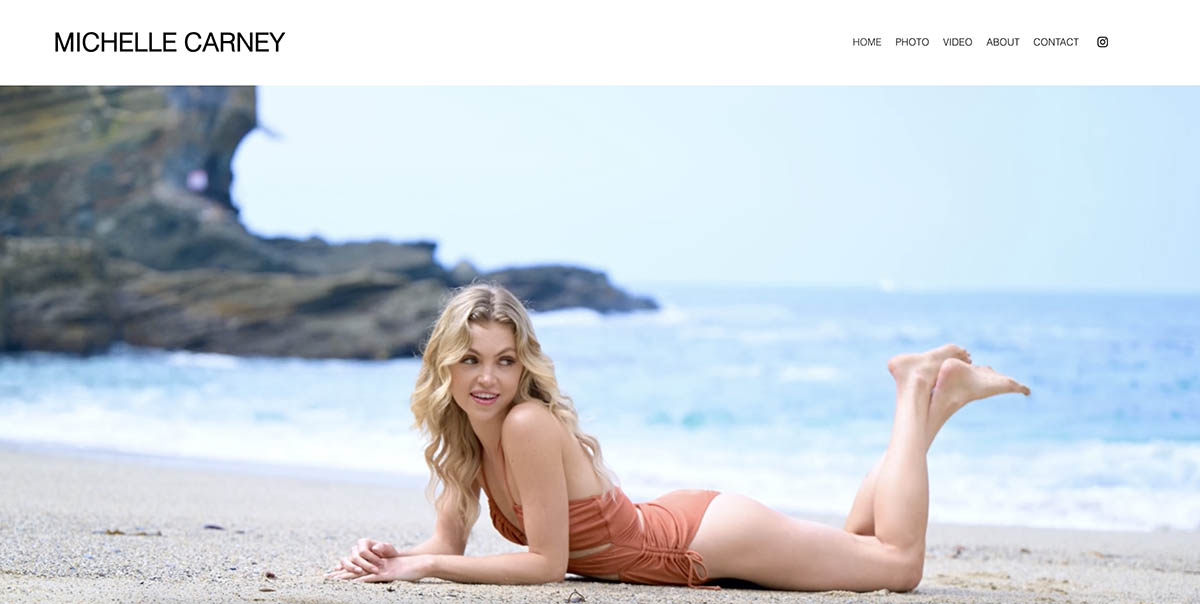
A clean grid design helps Michelle's photos stand out. Her portfolio is an excellent example of using a template that reinforces her brand identity.
By including only the best example of each style, she's created a stunning portfolio that also includes a video montage of her video and runway work
SEO tips for modeling portfolios
Having an SEO-friendly modeling portfolio means it's more likely that agencies, clients, and your audience can find you online. While SEO can seem complicated, online website builders like Journo Portfolio often automatically optimize the SEO for you or make it easy to do it yourself.
For more information about making your modeling portfolio SEO savvy, check out our complete guide here.
A few quick FAQs about model portfolios
What is a model portfolio?
A model portfolio is a collection of photos, videos and brand work that showcase a model's unique style and professional experience. It can be in print or digital.
How to build a modeling portfolio?
You can build a modeling portfolio by working with a web designer or by creating one yourself with web builders and online portfolio platforms. You'll also need to work with a photographer to create a collection of high-quality photos you can include.
What should a model portfolio look like?
Model portfolios should be clean and simple, with easy to access contact info and an About page that states your general work experience. Visually stunning, your photos should take center stage and should be able to speak for you.

